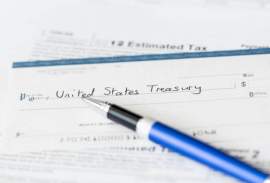
California Tax

FULL List to California Tax Forms
Individual Income Tax Forms
Form 540 California Resident Income Tax Return
Form 540 2EZ California Income Tax Return
Form 540NR California Nonresident or Part-Year Resident Income Tax Return
From 540NR California Nonresident or Part-Year Resident Income Tax Return Long
Corporate Income Tax Forms
Form 100 California Corporation Franchise or Income Tax Return
Form 100S California S Corporation Franchise or Income Tax Return
Form 100X Amended Corporation Franchise or Income Tax Return
Sales Tax Forms
Form BOE401 EZ Sales and Use Tax Return (Short Form)
Property Tax Forms
Form 540 California Resident Income Tax Return
Form Schedule D-1 Sales of Business Property
Form 3567 Installment Agreement Request
Form 3561 Installment Agreement Financial Statement
Form 3557E Application for Certificate of Revivor
Primary Concerns:
The most pertinent issue facing California in terms of its deficit is the state's absolutely staggering budget deficit, which as of early 2010 was estimated to be about half of a trillion dollars. The cause of California's budget problems are based on a multitude of factors, but many have been driven by the diverse, and highly unstable, California economy and issues of government taxation and spending.
California, as the third largest state and extended over much of the west coast of the United States, is a geographically extended region, conversely containing some of the most economically prosperous and financially depressed regions in the entire country.
Much of the state's economy, which is the tenth largest in the world, is based on agriculture, which has been highly unstable industry despite its dramatic growth in the last few decades, and whose work force employs a number of very underpaid workers unable to contribute heavily in income taxes.
A large portion of this work force also consists of number illegal alien workers who pay no taxes to the state at all. Simultaneously, to maintain its business and technological sectors, California implemented a number of systematic tax incentives to keep businesses operating in state and employing resident Californians, which again limited the amount of tax revenue the state was able to collect.
Much of California's tax rates are also set through the process of voter referendum, where a state electorate decides some legislative matters through popular vote, taking them out of the hands of legislative government.
This lack of revenue, despite California boasting some of the highest rates of taxation in the country, combined with a state that dramatically spent far beyond its means, proved to be a recipe for what became an economic crisis
Currently California's economic crisis has been so bad that the state is nearly insolvent, unable to finance its basic services within its budget, with its credit so poor it is unable to borrow to make up the difference. As a result, California has been forced to try to slash the state budget by 25%, which has led to furloughs of state employees (which mean lost tax income).
The role that taxation will play in trying to solve this crisis remains to be seen, but for many who are concerned about deficit spending, California remains a cautionary case of what can happen when a state spends more than it can take in. Depending on how much one believes the mantra, "Where California goes, America follows...," the implications of this crisis can be severe indeed.
Income Tax:
Anyone residing in California full of part time and who earns income generated from within the state is required to pay income taxes. California's income tax rates are some of the highest in the country, requiring a flat tax in addition to a percentage of income over the given tax bracket threshold.
For a single or married individual filing separately, with incomes between zero and $7060, the tax is zero plus 2.25% of all amounts of the base of zero. Between $7,060 and $16,739 the tax is $88.25 plus 2.25% rate of all amounts over the base $7,060.
When the income is between $16,739 and $26,419 the tax is $306.03 plus 4.25% over the base. For incomes between $26,419 and $36,675, the tax is $717.43 plus 6.25% over the base. Between $36,675 and $46,349, the tax is $1,358.43 plus 8.25% over the base. And finally, incomes of $46,349 have a tax of $2,156.54 plus 9.55% rate on all income over that level.
In married couples filing jointly and qualifying widows and widowers with dependent child or children, everything but the tax rates over the base is doubled. For instance, the first tax bracket is between zero and $14,120 instead of zero and $7,060. The next level is between $14,120 and $33,478 with a tax of 176.50 (double $88.25) with 2.25% above the base of $14,120.
For heads of household, incomes between zero and $14,130 have zero base tax plus 1.25% above the base of zero. Between $14,130 and $33,479 the tax is $176.63 plus 2.25% above the base.
The tax and rate above the base for incomes between $33,479 and $43,157 is $611.98 plus 4.25%. Between $43,157 and $53,412 the tax is $1,023.30 plus 6.25% above the base, and between $53,412 and $63,089 the tax is $1664.24 with 8.25% above the base. Any income $63,089 and over has a tax of $2,462.59 plus 9.55%.
While California has some of the highest income taxes in the nation, they also feature some of the most progressive in terms of their graduation of tax and rates. Nevertheless, for a state that contains the most millionaires of any state (a population that numbers well into the hundreds of thousands), there are some that feel that the rates are simply not progressive enough.
Corporate Income Tax:
Corporate tax rates in California are fairly specialized between general corporations and financial and banking institutions. The corporate tax rate is 8.84%, while for financial institutions it is 10.84%. The alternative minimum tax for corporations are 6.65%, which many criticize is too low in comparison to the other two since it nearly always guarantees that the other two rates will be higher.
For S corporations and bank and financial institutions, which are protected from double taxation, meaning the taxes are passed on the shareholders only instead of shareholders and company, the rates are much, much lower: 1.5% for regular S corporations, and 3.5% for banks and financial institutions.
Property Tax:
In California, unless a certain form of property has been exempted, nearly all forms of property are subject to taxation. Property taxes in California generally fall into one of two categories, secured and unsecured. Secured properties are those that become a lien if the taxes are not paid to the government, and mainly consist of real estate, including a home, business, residential complexes such as apartment buildings, vacant property, and so on. Improvements to a property also fall under the category of secured property, and can include landscape additions such as fruit trees, ornamental vines, and concrete based structures (agricultural crops are generally NOT covered as secured property).
Unsecured property is property that does not have tax lien placed against it, usually those used in a business, such as portable machinery, including farm machinery, industrial tools, and office equipment, as well as some high end transport vehicles, such as boats and planes.
Property tax is based on the assessed value of a property, as performed by a county assessor, and will generally be limited to one percent of the property's assessed worth. However, additions in the form of levies and special assessments may be added to property taxes by local counties, in the interest of paying off voter approved tax bonds or other remarkable cases of indebtedness. These levies can be contested with the county tax collector, but until a determination has been made, they still must be paid or risk violating the tax law.
Sales Tax:
California has the highest sales and use tax rate in the country, at 8.25%. However, depending on what city a consumer makes a purchase in the rate could be far higher, as individual taxing districts can add their own sales tax on top of existing sales tax. Some districts choose to do so, but many commonly add at least add an extra 0.25%, and some areas add substantially more. Los Angeles, for instance, the largest city in California and the second largest in the entire United States, has a combined sales tax of 9.75%. The highest sales taxes are in the cities of South Gate and Pico Rivera, both in the L.A. Metropolitan area, which have combined tax rates of 10.75%.
In breaking down the California sales tax: 5.00% goes to the California State general fund, 1.00% goes to the Uniform Local Tax, 0.25% goes to State's Fiscal recover fund, 0.50% goes to the Local Revenue Fund, another 0.50% goes to Local Public Safety funds, and the final 1.00% is divided up for the local city or county, with 0.75% going to operational funds and the last 0.25% going to the local transportation fund.
All taxes are passed either locally or statewide, through California's policy of voter referendum.
California sales taxes are also not do not apply to most groceries and prescription drug sales.
Tax Forms:
California tax forms are some of the most comprehensive and extensive in the country, and as a result there are literally dozens of forms for individual taxpayers, with many more for businesses.
Most individual state tax returns are variations on the 540 return, which is the California Resident Income Tax Return, which comes in as the 540 2EZ form (which is a short form of the 540), the 540 ES form (for estimated taxes), and the 540NR (which is for nonresidents or part time residents). Most of these forms are available online, and there is a considerable industry in California built around the intricacies of California income tax preparation.
NEXT: Colorado State Tax




















